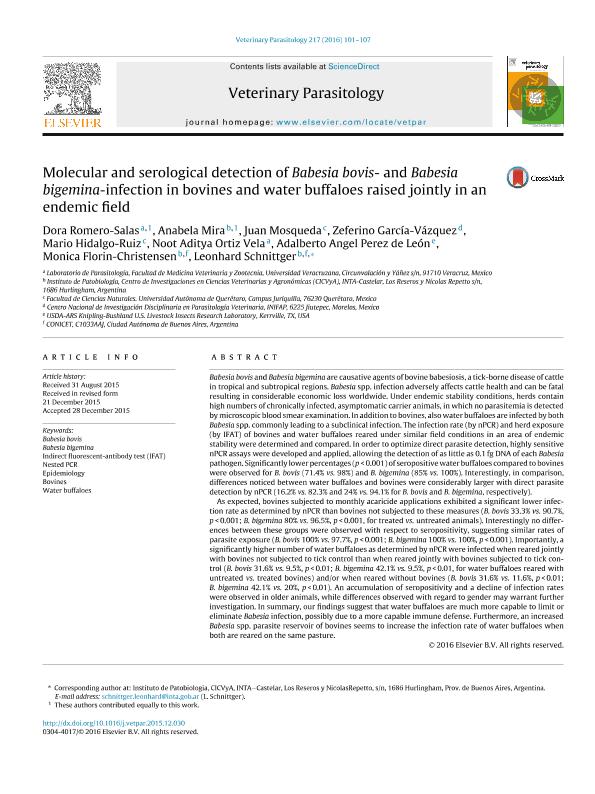Mostrar el registro sencillo del ítem
dc.contributor.author
Romero-Salas, Dora
dc.contributor.author
Mira, Anabela

dc.contributor.author
Mosqueda, Juan
dc.contributor.author
García Vázquez, Zeferino
dc.contributor.author
Hidalgo Ruiz, Mario
dc.contributor.author
Vela, Noot Aditya Ortiz
dc.contributor.author
de León, Adalberto Ángel Pérez
dc.contributor.author
Florín Christensen, Monica
dc.contributor.author
Schnittger, Leonhard

dc.date.available
2019-03-29T21:57:39Z
dc.date.issued
2016-02
dc.identifier.citation
Romero-Salas, Dora; Mira, Anabela; Mosqueda, Juan; García Vázquez, Zeferino; Hidalgo Ruiz, Mario; et al.; Molecular and serological detection of Babesia bovis- and Babesia bigemina-infection in bovines and water buffaloes raised jointly in an endemic field; Elsevier Science; Veterinary Parasitology; 217; 2-2016; 101-107
dc.identifier.issn
0304-4017
dc.identifier.uri
http://hdl.handle.net/11336/72886
dc.description.abstract
Babesia bovis and Babesia bigemina are causative agents of bovine babesiosis, a tick-borne disease of cattle in tropical and subtropical regions. Babesia spp. infection adversely affects cattle health and can be fatal resulting in considerable economic loss worldwide. Under endemic stability conditions, herds contain high numbers of chronically infected, asymptomatic carrier animals, in which no parasitemia is detected by microscopic blood smear examination. In addition to bovines, also water buffaloes are infected by both Babesia spp. commonly leading to a subclinical infection. The infection rate (by nPCR) and herd exposure (by IFAT) of bovines and water buffaloes reared under similar field conditions in an area of endemic stability were determined and compared. In order to optimize direct parasite detection, highly sensitive nPCR assays were developed and applied, allowing the detection of as little as 0.1 fg DNA of each Babesia pathogen. Significantly lower percentages (p < 0.001) of seropositive water buffaloes compared to bovines were observed for B. bovis (71.4% vs. 98%) and B. bigemina (85% vs. 100%). Interestingly, in comparison, differences noticed between water buffaloes and bovines were considerably larger with direct parasite detection by nPCR (16.2% vs. 82.3% and 24% vs. 94.1% for B. bovis and B. bigemina, respectively).As expected, bovines subjected to monthly acaricide applications exhibited a significant lower infection rate as determined by nPCR than bovines not subjected to these measures (B. bovis 33.3% vs. 90.7%, p < 0.001; B. bigemina 80% vs. 96.5%, p < 0.001, for treated vs. untreated animals). Interestingly no differences between these groups were observed with respect to seropositivity, suggesting similar rates of parasite exposure (B. bovis 100% vs. 97.7%, p < 0.001; B. bigemina 100% vs. 100%, p < 0.001). Importantly, a significantly higher number of water buffaloes as determined by nPCR were infected when reared jointly with bovines not subjected to tick control than when reared jointly with bovines subjected to tick control (B. bovis 31.6% vs. 9.5%, p < 0.01; B. bigemina 42.1% vs. 9.5%, p < 0.01, for water buffaloes reared with untreated vs. treated bovines) and/or when reared without bovines (B. bovis 31.6% vs. 11.6%, p < 0.01; B. bigemina 42.1% vs. 20%, p < 0.01). An accumulation of seropositivity and a decline of infection rates were observed in older animals, while differences observed with regard to gender may warrant further investigation. In summary, our findings suggest that water buffaloes are much more capable to limit or eliminate Babesia infection, possibly due to a more capable immune defense. Furthermore, an increased Babesia spp. parasite reservoir of bovines seems to increase the infection rate of water buffaloes when both are reared on the same pasture.
dc.format
application/pdf
dc.language.iso
eng
dc.publisher
Elsevier Science

dc.rights
info:eu-repo/semantics/openAccess
dc.rights.uri
https://creativecommons.org/licenses/by-nc-sa/2.5/ar/
dc.subject
Babesia Bigemina
dc.subject
Babesia Bovis
dc.subject
Bovines
dc.subject
Epidemiology
dc.subject
Indirect Fluorescent-Antibody Test (Ifat)
dc.subject
Nested Pcr
dc.subject
Water Buffaloes
dc.subject.classification
Ciencias Veterinarias

dc.subject.classification
Ciencias Veterinarias

dc.subject.classification
CIENCIAS AGRÍCOLAS

dc.title
Molecular and serological detection of Babesia bovis- and Babesia bigemina-infection in bovines and water buffaloes raised jointly in an endemic field
dc.type
info:eu-repo/semantics/article
dc.type
info:ar-repo/semantics/artículo
dc.type
info:eu-repo/semantics/publishedVersion
dc.date.updated
2019-03-29T12:13:43Z
dc.journal.volume
217
dc.journal.pagination
101-107
dc.journal.pais
Países Bajos

dc.journal.ciudad
Amsterdam
dc.description.fil
Fil: Romero-Salas, Dora. Universidad Veracruzana; México
dc.description.fil
Fil: Mira, Anabela. Consejo Nacional de Investigaciones Científicas y Técnicas; Argentina. Instituto Nacional de Tecnología Agropecuaria. Centro de Investigación en Ciencias Veterinarias y Agronómicas. Instituto de Patobiología; Argentina
dc.description.fil
Fil: Mosqueda, Juan. Universidad Autónoma de Querétaro; México
dc.description.fil
Fil: García Vázquez, Zeferino. Instituto Nacional de Investigaciones Forestales, Agrícolas y Pecuarias. Centro Nacional de Investigación Disciplinaria en Parasitología Veterinaria; México
dc.description.fil
Fil: Hidalgo Ruiz, Mario. Universidad Autónoma de Querétaro; México
dc.description.fil
Fil: Vela, Noot Aditya Ortiz. Universidad Veracruzana; México
dc.description.fil
Fil: de León, Adalberto Ángel Pérez. United States Department of Agriculture. Agricultural Research Service; Argentina
dc.description.fil
Fil: Florín Christensen, Monica. Instituto Nacional de Investigaciones Forestales, Agrícolas y Pecuarias. Centro Nacional de Investigación Disciplinaria en Parasitología Veterinaria; México
dc.description.fil
Fil: Schnittger, Leonhard. Consejo Nacional de Investigaciones Científicas y Técnicas; Argentina. Instituto Nacional de Investigaciones Forestales, Agrícolas y Pecuarias. Centro Nacional de Investigación Disciplinaria en Parasitología Veterinaria; México
dc.journal.title
Veterinary Parasitology

dc.relation.alternativeid
info:eu-repo/semantics/altIdentifier/url/http://www.sciencedirect.com/science/article/pii/S030440171530114X
dc.relation.alternativeid
info:eu-repo/semantics/altIdentifier/doi/https://doi.org/10.1016/j.vetpar.2015.12.030
Archivos asociados
